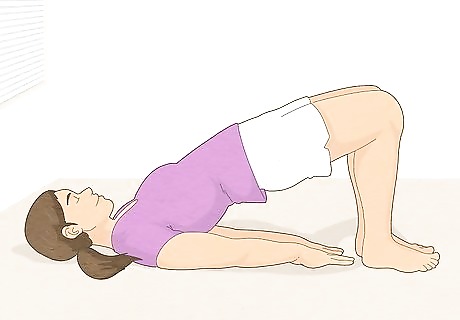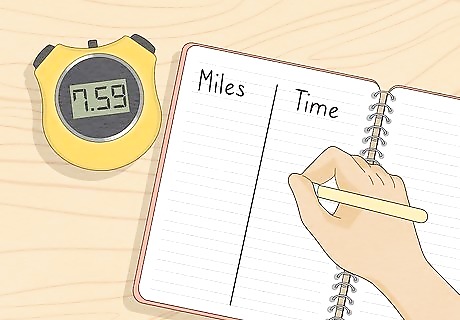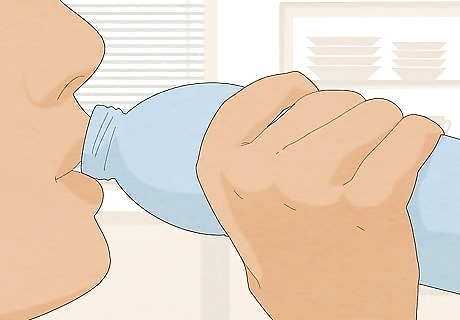
views
- Make sure your shoulders are back, your head is held high, and you're staring straight ahead as you run. Running with good form will help you run faster.
- Try using shorter strides. Long strides actually slow you down.
- Practice sprinting, running hills, and going for long runs. Doing all of these things consistently will help you improve your mile time.
Take shorter strides.

Strides that are too long can actually slow you down. With each step, your foot should land directly beneath your body with your knee slightly bent. If your foot is landing in front of your body, then you are taking too long of a stride. Push back every time your feet hit the ground. This will help support your momentum.
Do 1 long run a week.

Distance running improves your stamina and speed. Pick a distance that’s a bit further than you’d normally run at one time. Then, try to run that amount every single week. If you can run a longer distance than 1 mile successfully, you’ll train your body to keep going and not give up once you start to get tired. It doesn’t have to be a marathon—even running 2 miles when you usually run 1 mile is enough. Running long distances also helps improve your mental stamina and durability.
Add strength training to your routine.

Strength training will improve your stamina and speed. Focus on lower body exercises, like weighted squats, lunges, and deadlifts to strengthen your legs for a faster run time.
Run hills.

Hill training increases both your stamina and your running power. At least once a week, try to incorporate running up and down hills. Running hills helps strengthen your leg muscles and train your endurance for a faster mile. If you don’t have any hills nearby, try running on a treadmill with an incline setting. If you’ve never done it before, running uphill can be a challenge at first. Just remember that it will get easier with time.
Pace yourself.

Avoid doing too much too soon. While it’s great to be motivated and want to improve your mile time right away, working out too much too quickly can lead to injury. Shave off your mile time gradually, and be patient with yourself as you work toward your goals. Be sure to incorporate 1 to 2 rest days into your weekly routine. Rest days give your muscles a chance to recover, which actually makes them stronger over time. Some runners see results in a few weeks, but some have to wait months until they see any change. Rest assured that you can reach your goal if you give yourself enough time.
Run with good form.

Bad form can prevent you from running faster. If you’re struggling to shave seconds off your mile, take a step back and examine your form. If you are slouched or flat-footed, that could be the reason why your mile time isn’t improving. Keep your shoulders back and stare straight ahead, and run with your head held high. Look at the horizon, not at your feet. Tilting your head at this angle will align and straighten your neck and back. Keep your shoulders level and loose. If they start to come up toward your ears, then stop running and shake them out or stretch them gently. Place your arms at a 90-degree angle and allow them to go forward and backward instead of across your body. Keep your fists unclenched with your finger lightly touching your palms.
Set a goal for yourself.

A tangible goal will make it easier to train your way to a faster mile. Whether it’s a specific time limit or how many seconds you want to shave off, start out by creating a goal that’s both attainable and motivating. Your goal might be: “I want to run a 7 minute mile.” “I want to shave 30 seconds off of my mile.” “I want to get down to a 10 minute mile.” Usain Bolt Usain Bolt, Olympic Sprinter Hard work pays off. "I think a lot of people, they see you run and they say, ‘it looks so easy, looks effortless’. But before it gets to that point, it’s hard; it’s hard work."
Practice sprinting.

Sprinting prepares your body to run fast when you need to. Try sprinting for 30 seconds, then jogging for 60 seconds, and repeating that sequence 8 times. Over time, you’ll notice your sprints getting faster and your breathing slowing down. You can also try doing a tempo run, which is a run that’s slightly faster than your top speed.
Try interval training.

Interval training increases your stamina and strengthens your muscles. To do interval training, run as fast as you can for 1 to 2 minutes, then slow down to your normal speed for another 1 to 2 minutes. Keep doing this over and over until you can’t workout any longer. Interval training is all about pushing your body to its limits. If you feel tired and worn out at the end, that’s a good sign!
Stretch after warmups and cool downs.

Stretching lengthens your muscles and helps you run faster. Plus, it helps avoid injury. Stretching after a run improves your blood flow and can even increase your range of motion, leading to a better running posture. After you warm up and cool down for the day, try stretches like: Glute bridge Pigeon pose Figure-4 stretch
Track your mile time.

Keep a record of how fast you’re running day by day. It’s hard to know how much you’re improving if you aren’t quite sure how fast you’re running. Whenever you set out to run a mile, keep a stopwatch going to see how fast you can make it. Note your average mile time and then aim for a faster mile from there. Try using the stopwatch on your phone so you can have it on your person while you run.
Run with a buddy.

A running partner is encouraging and motivating. Choose someone who runs about the same speed as yourself if possible, since this provides encouragement and friendly competition. While you can train alone, training with a team of similar runners is a huge motivation booster. A running buddy will also hold you accountable to meet your fitness goals. It’s a lot easier to blow off your run for the day if you’re by yourself; but if you have to cancel on another person, you’re more likely to get out there and do it.
Drink plenty of water.

Staying hydrated will keep your body functioning well. Aim for around 64 fluid ounces (2 L) of liquid a day so you can focus on running instead of being thirsty. If you don’t love water, try sports drinks instead. Invest in a hydration pack or hydration vest if you don't feel like carrying a water bottle.

















Comments
0 comment